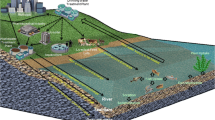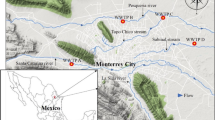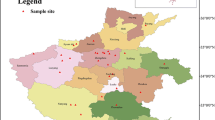Abstract
The occurrence, fate and ecotoxicological assessment of selected estrogenic compounds were investigated at Tunisian urban sewage treatment plant. The influents, effluents, as well as primary, secondary and dehydrated sludge, were sampled and analyzed for the target estrogens to evaluate their fate. All target compounds were detected in both sewage and sludge with mean concentrations from 0.062 to 0.993 μg L−1 and from 11.8 to 792.9 μg kg−1dry weight, respectively. A wide range of removal efficiencies during the treatment processes were observed, from 6.3 % for estrone to 76.8 % for estriol. Ecotoxicological risk assessment revealed that the highest ecotoxicological risk in sewage effluent and dehydrated sludge was due to 17β-estradiol with a risk quotient (RQ) of 4.6 and 181.9, respectively, and 17α-ethinylestradiol with RQ of 9.8 and 14.85, respectively. Ecotoxicological risk after sewage discharge and sludge disposal was limited to the presence of 17β-estradiol in dehydrated-sludge amended soil with RQ of 1.38. Further control of estrogenic hormones in sewage effluent and sludge is essential before their discharge and application in order to prevent their introduction into the natural environment.




Similar content being viewed by others
References
Angelakis AN, Durham B (2008) Water recycling and reuse in EUREAU countries: trends and challenges. Desalination 218:3–12
Barron L, Havel J, Purcell M, Szpak M, Kelleher B, Paull B (2009) Predicting sorption of pharmaceuticals and personal care products onto soil and digested sludge using artificial neural networks. Analyst 134:663–670
Belhaj D, Baccar R, Jaabiri I, Bouzid J, Kallel M, Ayadi H, Zhou JL (2015) Fate of selected estrogenic hormones in an urban sewage treatment plant in Tunisia (North Africa). Sci Total Environ 505:154–160
Belhaj D, Jaabiri I, Ayadi H, Kallel M, Zhou JL (2014) Occurrence and removal of steroidal estrogens in Centre Eastern Tunisia municipal sewage treatment plant. Desalination and Water Treatment 52 (10–12):2330–2339
Carballa M, Omil F, Lema JM (2008) Comparison of predicted and measured concentrations of selected pharmaceuticals, fragrances and hormones in Spanish sewage. Chemosphere 72:1118–1123
Chen K, Zhou JL (2014) Occurrence and behavior of antibiotics in water and sediments from the Huangpu River, Shanghai, China. Chemosphere 95:604–612
Chen W, Xu J, Lu S, Jiao W, Wu L, Chang AC (2013) Fates and transport of PPCPs in soil receiving reclaimed water irrigation. Chemosphere 93:2621–2630
De Souza SM, Vasconcelos EC, Dziedzic M, De Oliveira CM (2009) Environmental risk assessment of antibiotics: an intensive care unit analysis. Chemosphere 77:962–967
European Commission (2003) TGD. Technical Guidance Documents in Support of Commission Directive 93/67/EEC on Risk Assessment, Part II 2003. Italy. 153
Goeppert N, Dror I, Berkowitz B (2014) Detection, fate and transport of estrogen family hormones in soil. Chemosphere 95:336–345
Grover D, Zhou JL, Frickers PE, Readman JW (2011) Improved removal of estrogenic and pharmaceutical compounds in sewage effluent by full scale granular activated carbon: impact on receiving river water. J Hazard Mater 185:1005–1011
Hanselman TA, Graetz DA, Wilkie AC, Szabo NJ, Diaz CS (2006) Determination of steroidal estrogens in flushed dairy manure wastewater by gas chromatography-mass spectrometry. J Environ Qual 35:695–700
Hernando MD, Mezcua M, Fernandez-Alba AR, Barcelo D (2006) Environmental risk assessment of pharmaceutical residues in wastewater effluents, surface waters and sediments. Talanta 69:334–342
Jelic A, Fatone F, Di Fabio S, Petrovic M, Cecchi F, Barcelo D (2012) Tracing pharmaceuticals in a municipal plant for integrated wastewater and organic solid waste treatment. Sci Total Environ 433:352–361
Karnjanapiboonwong A, Chase DA, Canas JE, Jackson WA, Maul JD, Morse AN, Anderson TA (2011) Uptake of 17α-ethynylestradiol and triclosan in pinto bean, Phaseolus vulgaris. Ecotoxicol Environ Saf 74:1336–1342
Koh YK, Chiu TY, Boobis AR, Scrimshaw MD, Bagnall JP, Soares A, Pollard S, Cartmell E, Lester JN (2009) Influence of operating parameters on the biodegradation of steroid estrogens and nonylphenolic compounds during biological wastewater treatment processes. Environ SciTechnol 43:6646–6654
Liu R, Zhou JL, Wilding A (2004) Simultaneous determination of endocrine disrupting phenolic compounds and steroids in water by solid-phase extraction-gas chromatography-mass spectrometry. J Chromatogr A 1022:179–189
Martín J, Camacho-Munoz D, Santos J, Aparicio I, Alonso E (2011) Monitoring of pharmaceutically active compounds in Guadalquivir River basin (Spain): occurrence and risk assessment. J Environ Monit 13:2042–2049
Martín J, Camacho-Muñoz D, Santos JL, Aparicio I, Alonso E (2012) Occurrence of pharmaceutical compounds in wastewater and sludge from wastewater treatment plants: removal and ecotoxicological impact of wastewater discharges and sludge disposal. J Hazard Mater 239(24):40–47
Maskaoui K, Zhou JL (2010) Colloids as a sink for certain pharmaceutical in the aquatic environment. Environ Sci Pollut Res 17:898–907
Miege C, Choubert JM, Ribeiro L, Eusebe M, Coquery M (2009) Fate of pharmaceuticals and personal care products in wastewater treatment plants - conception of a database and first results. Environ Pollut 157:1721–1726
Nakada N, Tanishima T, Shinohara H, Kiri K, Takada H (2006) Pharmaceutical chemical and endocrine disrupters in municipal wastewater in Tokyo and their removal during activated sludge treatment. Water Res 40:3297–3303
Nie MH, Yang Y, Liu M, Yan CX, Shi H, Dong WB, Zhou JL (2014a) Environmental estrogens in a drinking water reservoir area in Shanghai: occurrence, colloidal contribution and risk assessment. Sci Total Environ 487:785–791
Nie MH, Zhang ZJ, Yan CX, Wang XN, Li HJ, Dong WB (2014b) Degradation of chloramphenicol by thermally activated persulfate in aqueous solution. Chem Eng J 246:373–382
Nie Y, Qiang Z, Zhang H, Adams C (2009) Determination of endocrine-disrupting chemicals in the liquid and solid phases of activated sludge by solid phase extraction and gas chromatography–mass spectrometry. J Chromatogr A 1216:7071–7080
Paterakis N, Chiu TY, Koh KK, Lester JN, McAdam E, Scrimshaw MD, Soares A, Cartmell E (2012) The effectiveness of anaerobic digestion in removing estrogens and nonylphenol ethoxylates. J Hazard Mater 199:88–95
Petrie B, Barden R, Kasprzyk-Hordern B (2014) A review on emerging contaminants in wastewaters and the environment: current knowledge, understudied areas and recommendations for future monitoring. Water Res 72:3–27
Plumlee MH, Gurr CJ, Reinhard M (2012) Recycled water for stream flow augmentation: benefits, challenges, and the presence of wastewater-derived organic compounds. Sci Total Environ 438:541–548
Santos LH, Araujo AN, Fachini A, Pena A, Delerue-Matos C, Montenegro MC (2010) Ecotoxicological aspects related to the presence of pharmaceuticals in the aquatic environment. J Hazard Mater 175:45–95
Sarmah AK, Northcott GL, Scherr FF (2008) Retention of estrogenic steroid hormones by selected New Zealand soils. Environ Int 34:749–755
Schaider LA, Rudel RA, Ackerman JM, Dunagan SC, Brody JG (2014) Pharmaceuticals, perfluoro surfactants, and other organic wastewater compounds in public drinking water wells in a shallow sand and gravel aquifer. Sci Total Environ 468(469):384–393
Silva CP, Otero M, Esteves V (2012) Processes for the elimination of estrogenic hormones from water: a review. Environ Poll 165:38–58
Sim WJ, Lee JW, Shin SK, Song KB, Oh JE (2011) Assessment of fates of estrogens in wastewater and sludge from various types of wastewater treatment plants. Chemosphere 82:1448–1453
Stasinakis AS, Thomaidis NS, Arvaniti OS, Asimakopoulos AG, Samaras VG, Ajibola A, Mamais D, Lekkas TD (2013) Contribution of primary and secondary treatment on the removal of benzothiazoles, benzotriazoles and three other classes of emerging contaminants in sewage treatment plant. Sci Total Environ 463-464:1067–1075
Stevens-Garmon J, Drewes JE, Khan SJ, McDonald JA, Dickenson ER (2011) Sorption of emerging trace organic compounds onto wastewater sludge solids. Water Res 45:3417–3426
Ternes TA, Joss A (2006) Human pharmaceuticals, hormones and fragrances: the challenge of micropollutants in urban water management. IWA Publishing
Venkatesan AK, Done HY, Halden RU (2015) United States National Sewage Sludge Repository at Arizona State University-a new resource and research tool for environmental scientists, engineers and epidemiologists. Environ Sci Pollu tRes 22(3):1577–1586
Xu N, Xu YF, Xu S, Li J, Tao HC (2012) Removal of estrogens in municipal wastewater treatment plants: a Chinese perspective. Environ Pollut 165:215–224
Yang G, Zhang G, Wang H (2015) Current state of sludge production, management, treatment and disposal in China. Water Res 78:60–73
Yu Y, Wu L (2012) Analysis of endocrine disrupting compounds, pharmaceuticals and personal care products in sewage sludge by gas chromatography-mass spectrometry. Talanta 89:258–263
Zhang W, Li Y, Su Y, Mao K, Wang Q (2012) Effect of water composition on TiO2 photocatalytic removal of endocrine disrupting compounds (EDCs) and estrogenic activity from secondary effluent. J Hazard Mater 215-216:252–258
Zhang Y, Zhou JL (2008) Occurrence and removal of endocrine disrupting chemicals in wastewater. Chemosphere 73(5):848–853
Zorita S, Martensson L, Mathiasson L (2009) Occurrence and removal of pharmaceuticals in a municipal sewage treatment system in the south of Sweden. Sci Total Environ 407:2760–2770
Acknowledgements
The authors would like to thank the local authorities in Tunisia for kindly allowing us to take sewage samples.
Author information
Authors and Affiliations
Corresponding author
Ethics declarations
Conflict of interest
The authors declare that the research was conducted in the absence of any commercial or financial relationships that could be regarded as a potential conflict of interest.
Ethical approval
The authors declare that they have no research involving human or animals participants.
Informed consent
The authors declare that they have informed consent from the Tunisian local authorities to do this research.
Rights and permissions
About this article
Cite this article
Belhaj, D., Athmouni, K., Jerbi, B. et al. Estrogenic compounds in Tunisian urban sewage treatment plant: occurrence, removal and ecotoxicological impact of sewage discharge and sludge disposal. Ecotoxicology 25, 1849–1857 (2016). https://doi.org/10.1007/s10646-016-1733-8
Accepted:
Published:
Issue Date:
DOI: https://doi.org/10.1007/s10646-016-1733-8




